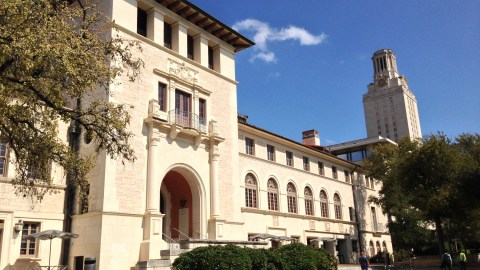University of Texas to offer free tuition for low-income students

Image source: Wimedia Commons
- The University of Texas at Austin will completely cover tuition for some qualifying low-income students, and partially cover tuition for some middle-income students.
- Students hoping to benefit from the program will still need to achieve the grades necessary to be accepted into the university.
- The move comes at a time when student loan debt is a key issue among 2020 Democratic presidential candidates.
The University of Texas at Austin plans to create a program that will make tuition more affordable for low- and middle-income students.
The University of Texas System Board of Regents unanimously voted to establish a $160 million endowment that, as Forbesreports, will:
- Completely cover tuition and fees for students from families that earn up to $65,000.
- Provide some financial aid to students from families with incomes of up to $125,000.
Only in-state students will be eligible for the program, which starts in the fall of 2020. The program is expected to completely cover tuition (but not board or living expenses) for some 8,600 low-income undergraduates, and about 5,700 middle-income students. The average in-state tuition at UT Austin is $10,314.
“Recognizing both the need for improved access to higher education and the high value of a UT Austin degree, we are dedicating a distribution from the Permanent University Fund to establish an endowment that will directly benefit students and make their degrees more affordable,” Chairman Kevin Eltife said in a statement.
Students must first be accepted into UT Austin — one of the nation’s most selective public universities — to benefit from the program. For context, Texas high school students must graduate in the top 6 percent of their class to be automatically accepted by the university, while students with lesser grades typically have to compensate with a high ACT score.
The Corpus Christi Caller-Times editorial board said society has an incentive to help high-achieving, underprivileged students attend university:
“If you qualify on both accounts, UT should be especially interested in enrolling you because it means you overcame more challenges to make those high grades than a rich kid who made high grades. Your demonstrated achievement suggests that by helping you, UT helps us all, and that by not helping you, UT and society in general run the risk of squandering your talents.
“Philosophically, this program should appeal to Texans of all political persuasions because it’s a hand up, not a handout.”
National student loan debt
Most 2020 Democratic presidential candidates want to make it financially easier for students to attend college, and for borrowers to pay off loans. Some candidates — among them, Sen. Bernie Sanders and Sen. Elizabeth Warren — want to make college completely free. Setting aside the economic implications of such policies, it’s easy to see why some candidates and many Americans want to tear down the financial hurdles that come with obtaining higher education.
According to Student Loan Hero and other 2019 statistics:
- Some 44 million Americans collectively owe $1.56 trillion in student loan debt.
- American student loan debt now represents a bigger debt category than both credit cards and auto loans.
- The average monthly student loan payment is $393.
- 11.5 percent of student loans have been delinquent or in default for more than 90 days.





